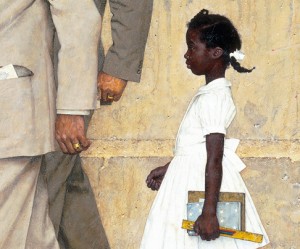In celebration of Martin Luther King Jr. Day, and her talk this Saturday, January 18, at 2 p.m., introducing “the other people in Norman Rockwell’s America,” we bring you the following essay courtesy of author Jane Allen Petrick:
Norman Rockwell Saved My Life

Norman Rockwell (1894-1978), “The Problem We All Live With” (crop), 1963. Oil on canvas. Illustration for “Look,” January 14, 1964. Norman Rockwell Museum Collections. ©Norman Rockwell Family Agency. All rights reserved.
In the winter of 1946, one year old Robin Jordan came to live with her Jamaican-American grandparents in their superintendent’s apartment on Eastern Parkway in Brooklyn. Her mother could no longer keep her. Her father had never been on the scene.
As soon as she could walk, Robin trailed behind her grandfather during his daily rounds to the utility rooms on each floor of their building. The old man would gather up the rubbish. Little Robin collected the discarded 10×12 pieces of cardboard the white, predominantly Jewish tenants of her building had received inside their freshly laundered, pressed and folded shirts.
Soon Robin Jordan was using these “easels” to turn out sketch after sketch, using whatever pens, pencils or, when they miraculously appeared, crayons she could lay her hands on.
*
I met Robin Jordan in 2010 while I was hanging out at The Brooklyn Museum of Art. As part of my research on the other people in Norman Rockwell’s America, I was asking people of color who were visiting Ron Schick’s show (Norman Rockwell: Behind The Camera, organized by Norman Rockwell Museum) why they had come.
Robin Jordan was there savoring the exhibit. She informed me that she had visited the show every day since it had opened. Now a retired fashion illustrator, Robin confided to me that when she was growing up, she had two heroes: Jackie Robinson and Norman Rockwell.
*
Seven year old Robin Jordan was small and skinny and dark. She could not read well. She could not write well. She could not talk well: she had a sever stutter.
Although her grandmother tightly braided down her thick, wooly hair, there wasn’t much money for bows. And then there was this: Robin was the only black child in her class, the grandbaby of building superintendents in a school dominated by the sons and daughters of well-to-do Jewish strivers. The stress and isolation of her reality only made Robin’s learning disorders worse.
By the time she was eleven years old, Robin Jordan was close to suicidal. Drawing was her only language, her only fluent means of communicating with the world. So when, as she was pouring through discarded magazines looking for images to copy, Robin came upon a photo of Norman Rockwell stating, “We’re looking for people who like to draw”, she felt the artist had thrown her a lifeline.
*
The Famous Artists’ School* was founded in 1948 by Norman Rockwell and Albert Dorne, another world-renowned illustrator. Glowingly described in hundreds of newspaper and magazine advertisements, the correspondence school offered the opportunity to study with and get feedback from Rockwell as well as eleven other “famous artists”. Thousands of aspiring illustrators from around the country sought to scrape together enough money for the monthly tuition. Some of them, like Robin Jordan, were black.
*
Later in life, Norman Rockwell would say that he just wanted to break out and do something important. Unbeknownst to him, Rockwell had already done something very important in the living legacy of the hundreds of black students whose only access to art instruction was and still is the studying and copying of his work. Many would say that Norman Rockwell gave them their careers and their livelihoods. Robin Jordan affirms that, for her, the gift was even greater: “Norman Rockwell saved my life.”
Jane Allen Petrick is the author of Hidden in Plain Sight: The Other People in Norman Rockwell’s America, available now in the Norman Rockwell Museum Store
*Norman Rockwell Museum has recently received a generous donation of the collection of The Famous Artists’ School. More details to come.

